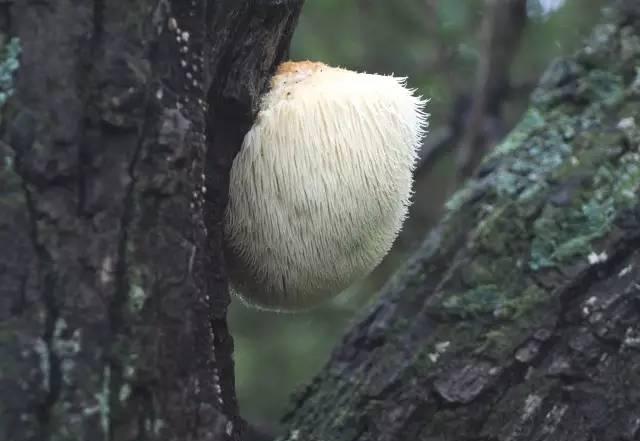
Hericium erinaceus (bull.) pers.
Taxonomic status: Basidiomycota, Umbellifera agaricomycetes, Red mushrooms russulales, Hericiaceae
Fir hericium abietis (weir ex hubert) k.a. harrison
Macroscopic form: Fruiting bodies are medium to large, annual. Fresh fruiting bodies are about 5–20 cm in diameter, oblate spherical, inverted ovate, or human head-shaped; white or milky surfaces that gradually turn yellow upon maturity; covered with dense spines, small spines about 1–4 cm long, cylindrical, tapering from the base to the apex, white when the surface of the spines is fresh, yellowish brown when dried, and the apex of the spines is darker in color. The flesh is white when fresh, and slightly yellow after drying. Sterile stalks or have short lateral stalks.
Microstructure: spore colorless, smooth, spherical, thick-walled, with an oil droplet in the middle, starchy, 5-6× 4.5-5.5 μm. The basidiot is long, rod-shaped, apically with 4 small stems and occasionally a lock-like joint at the base, 26-53 × 6-9 μm. The mycelium of the folds is colorless, relatively regularly arranged, almost unbranched, simply separated, with a lock-like joint at the septum, 3-11 μm in diameter. The lateral cysts are yellow-green and slender.
Market for dried hermaids
Minor individuals of Hericium hermanidae
Habitat: Usually grows on living or fallen trees of oak trees.
Growing season and collection method: Hericium erinaceus usually appears in summer and autumn, but is not common. The bacteria are closely related to the substrate and should be scraped up by a knife against the surface of the substrate during collection. The fungus is fleshy, perishable, and should be dried or dried in time after collection.
How to eat: Fresh fruiting bodies can be fried or soup after washing with water; if the dried fruiting bodies are soaked in warm water, they can stew chicken, stew fish or stir-fry. The most common way to eat Hericium in the northeast is to boil soup with water.
Herinaceus fresh market
Application value: The bacterium contains 26.3g of crude protein, 4.2g of fat, 44.9g of carbohydrates, 0.69mg of thiamine, 1.89mg of riboflavin, 0.01mg of carotene per 100g of dried products; the total amount of amino acids contained in it is 7.56%, and there are 7 kinds of essential amino acids (lysine, phenylalanine, methionine, threonine, isoleucine, leucine, valine), accounting for 41.40% of the total; there are 9 other amino acids, accounting for 58.60% of the total. The polysaccharides contained in Hericium herringii are anti-tumor, anti-mutation, anti-aging, anti-radiation, bacteriostatic, anti-coagulation, anti-leukocyte decline, liver protection, anti-fatigue and other functions.
Discussion: This species is similar to another edible mushroom, fir hericium abietis (weir ex hubert) k.a. harrison, but there are also certain differences between the two, the main differences being: the latter spores are small, colorless, smooth, nearly spherical, no oil droplets inside, 4-5 × 3-4 μm. Hericium coralloides (scop. :fr. )pers. Ex grav is also often eaten and has been domesticated.
About the Author
Tuligur, Doctor of Agronomy, Second-level Professor of Jilin Agricultural University, Doctoral Supervisor, Leader of The Discipline of Fungi Crops, Leader of the Innovation Team of the Ministry of Education, Taishan Scholar of Edible Mushroom Technology in Shandong Province, Director of the Chinese Mycological Society, Standing Member of the Expert Committee of the Chinese Edible Mushroom Association, Director of the Edible Mushroom Branch of the Chinese Agricultural Society, Editorial Board member of the Journal of Mycology and Mycological Research. Mainly engaged in the research of fungal diversity and resource conservation. More than 15,000 fungal specimens were collected and identified, more than 200 new records were found in China, more than 400 new records were recorded in various provinces and regions, 32 new species were named in 1 new genus, more than 600 kinds of fungi were described in detail, and three volumes of "Chinese Mycology" were edited (lateral ear and shiitake mushroom family, bulbous mushroom family, and silk limp family), and completed the molecular systematics framework of more than 20 important genera. He has presided over more than 20 projects such as the Ministry of Science and Technology's Basic Research Project, the National Natural Science Foundation of China, and the Ministry of Education's "Yangtze River Scholars and Innovation Team Program". He has published more than 150 papers and 8 books.
Professor Tulligur explains mushrooms in the wild
Professor Tulligur sorts out mushroom specimens
In addition to research, Professor Tu is keen on mushroom science education, and has published "Colorful Mushroom World", "Northeast Market Mushrooms", "Mushroom Pocket Book Series: 50 Kinds of Edible Mushrooms, 50 Kinds of Medicinal Mushrooms, 50 Kinds of Poisonous Mushrooms" and other popular science works, of which "Colorful Mushroom World" won the Silver Award for Excellent Works (Books) of the National Association of Popular Science Writers and the Shanghai Science Popularization Innovation Award.
(The copyright of the graphic content belongs to Tuligur, and if it needs to be reproduced, it needs to be agreed by me)